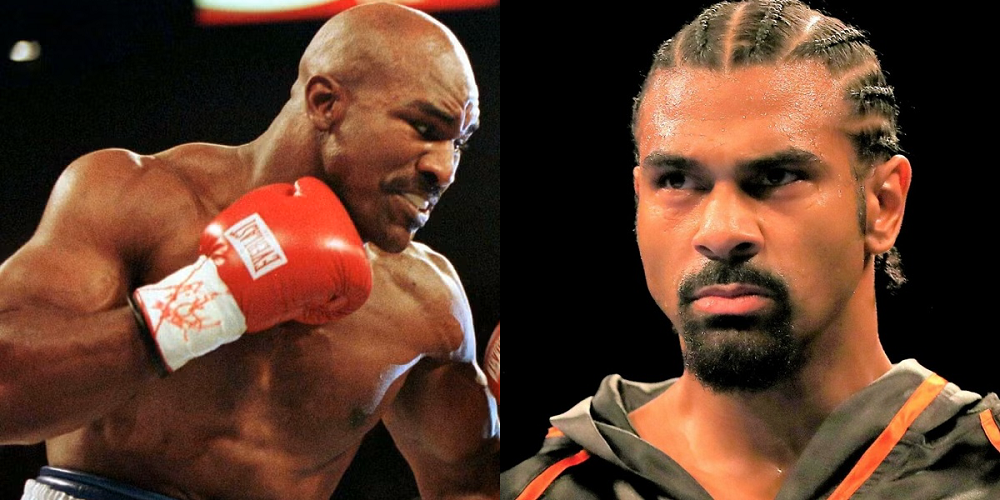The cruiserweight category is relatively young, having been officially introduced in boxing between the 1970s and 1980s. Therefore, the number of great champions who have competed in it is smaller compared to older divisions. Nonetheless, there have been cruiserweights capable of drawing attention due to their spectacularity, talent, and power. Today we will focus on two of them: Evander “The Real Deal” Holyfield and David “Hayemaker” Haye, imagining them on the same ring in their prime versions, obviously at the 200-pound limit.
Evander Holyfield: Technique and Power in the Service of the Show!
If the more mature version of Holyfield, the one capable of neutralizing the great Mike Tyson and competing in two fights against Lennox Lewis, was characterized by a certain caution and a remarkable ability to avoid excessive risks, the young Holyfield, who dominated the cruiserweight division, was a much more daring boxer. The Real Deal tried to turn every fight into a real battle, even when his qualities would have allowed him to win convincingly with far fewer risks. This was emblematic in his first encounter against Dwight Muhammad Qawi, where Holyfield chose to trade punches in the center of the ring for fifteen heated rounds when he could have won more easily by moving around and boxing from a distance. However, his way of attacking was not that of a crude brawler: even in the fiercest phases of the fights, Holyfield displayed remarkable counter-punching skills and an enormous variety of blows, along with a power that at 190 pounds (the cruiserweight limit in his time) was simply devastating.
David Haye: Reflexes, Agility, and Electrifying Punches
Haye’s deadly power, responsible for his very high knockout percentage (over 90% at the end of his career), was closely linked to his muscular reactivity. It was a type of power similar to that of Julian Jackson, or more recent names like Keith Thurman and Deontay Wilder: boxers who, by hitting the right spot, turn off the opponent’s lights, leaving them stunned on the ground. In defense, Hayemaker relied almost exclusively on his prodigious reflexes and excellent leg mobility, which became fully apparent to observers after the Englishman moved to the heavyweight division, where the size of his opponents often led him to use the ring’s width. Very reluctant to block punches with his arms, he preferred to dodge them with sudden torso movements and then come back with his terrible punches. When he didn’t quickly find the right opening for a knockout, Haye sometimes struggled with the pressure from opponents who, undeterred by his bombs, kept advancing without giving him a break. Knocked out by Carl Thompson when he was still inexperienced, Hayemaker was also put under pressure at times by Giacobbe Fragomeni and Jean Marc Mormeck, but he then knocked both out with his terrifying right hand.
Holyfield vs. Haye: The Fantasy Fight!
Weight class: Cruiserweight. Scheduled Rounds: 12.
Given the considerable disadvantage in terms of chin, David Haye would have certainly done everything possible to keep the pace of the fight low and limit close exchanges. After the aforementioned collapse against Thompson, which cost him his first career defeat, the Englishman became aware of his durability limits and adopted cautious and conservative approaches against opponents capable of hurting him. Most likely, Hayemaker would have started moving frenetically along the ropes from the first bell, occasionally and suddenly using his right hand to try to surprise his opponent attempting to close the distance. To chase down and pin a boxer as explosive and dangerous as Haye requires three ingredients: a very solid chin, lion-hearted courage, and considerable timing. It so happens that Evander Holyfield, especially in his younger years but not only, had all three, and thus he certainly would not have backed down from the challenge of hunting his opponent, forcing him to engage in battle. It’s difficult to determine how many rounds David Haye would have managed to stay away from his pursuer. Against Wladimir Klitschko, he succeeded for all twelve rounds, but the Ukrainian had no interest in getting too close, and Haye’s marathon-like approach prevented him from being dangerous, making his performance dull and inconclusive. Holyfield, certainly less worried than Klitschko about making mistakes, would have attacked head-on, perhaps taking some hard punches but eventually, in the middle rounds of the fight, finding himself in the right position to unleash his famous two-handed combinations. At that point, the outcome of the fight would have been sealed. Knocked out by Carl Thompson and Tony Bellew, knocked down by Lolenga Mock and Jean Marc Mormeck, Haye would never have been able to emerge unscathed from a close-quarters battle with The Real Deal. His downfall would have been a matter of time, but sooner or later, it would have happened.
Fantasy Prediction: David Haye would have managed for a few rounds to keep away from Holyfield by moving constantly and disturbing his opponent’s advance with sporadic counter punches. Holyfield would have gradually increased the pressure, taken some terrible rights with gritted teeth, and finally turned the fight into a war, emerging triumphantly in grand style. Result: Evander Holyfield wins by KO between the fifth and eighth rounds.

